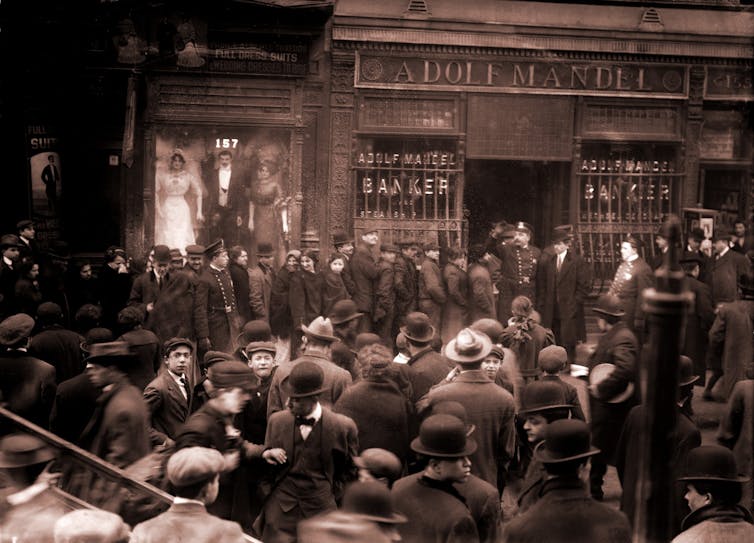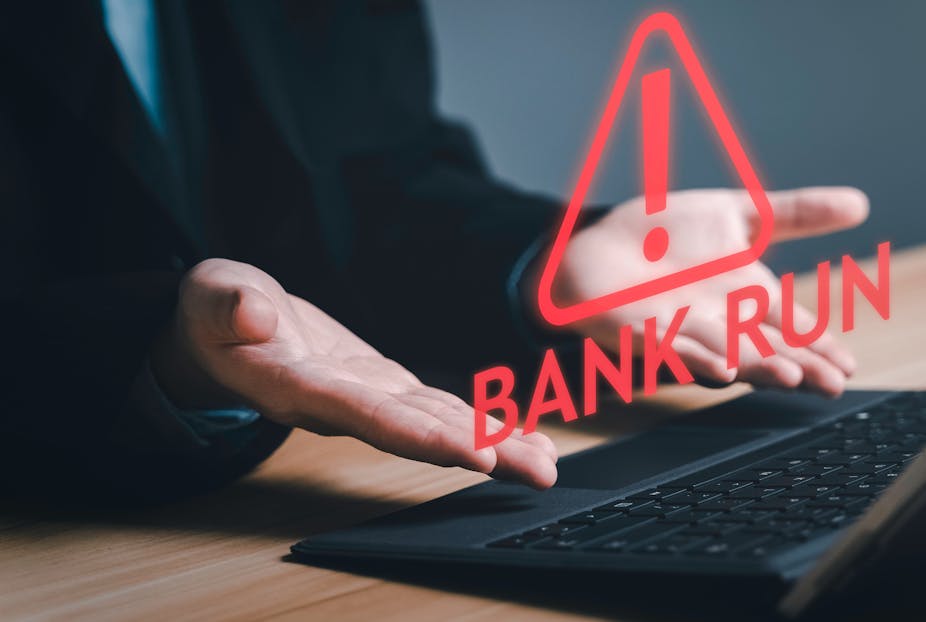A crisis of confidence in the US banking sector led people to pull their money from banks including Silicon Valley Bank and Credit Suisse, and more recently, First Republic Bank and California-based PacWest Bancorp. The way these events have unfolded have created a new term in the vocabulary of finance: “digital bank run”.
Unlike traditional bank runs, which conjure up images of people queuing outside a branch to withdraw their money in person, digital bank runs snowball even faster due to social media chatter. This can add to the sense of panic around the run.
Posts on Twitter with negative information about Silicon Valley Bank contributed to depositor withdrawals totalling US$40 billion (£32 billion) – 23% percent of total deposits – in a matter of hours, culminating in the bank’s failure. In contrast, it took Washington Mutual nine days to lose $17 billion (9% of its deposits) in 2008.
Digital bank runs are the new threat to financial stability that keeps regulators and investors awake at night. Like the toxic assets of the 2008 global financial crisis, they stem from a combination of new technology – social media, Twitter in particular – and the old complexities of the financial sector, in this case “fractional banking”.
Banks only keep a fraction of the money entrusted to them, investing the rest for profit. This means if a sufficiently large number of depositors demand their money back – typically out of fear about failure – the bank will not have enough. And then it really will fail. Concerns about a single bank may spread to other banks, leading to panic about the industry, widespread bank failures, and eventually, economic recession.
The Silicon Valley Bank crisis showed how the perils of fractional banking can be compounded by social media. Barring extreme situations such as queues of customers outside bank branches, it was difficult for negative information to spread from one customer to the next before social media.
But as a new, non-peer reviewed research paper suggests, a rise in negative tweets about Silicon Valley Bank before its March 10 collapse was followed by a drop in its stock price, seen as a proxy for deposits. The authors conclude that “social media did, indeed, contribute to the run on Silicon Valley Bank”.
Read more: Twitter played a role in the collapse of Silicon Valley Bank – new research
Avoiding a bank run
To avoid the kind of contagion that leads to digital bank runs, bank management, investors and regulators need to be careful about what they say. Even if they aren’t posting on social media, investors and other interested parties are, and their discussions can impact sentiment about a bank.
The failure of Credit Suisse was arguably kicked off by an ill thought-out comment by the chair of a major investor in the bank, Ammar Al Khudairy of Saudi National Bank. He did not comment publicly on this issue but resigned within two weeks “due to personal reasons” according to a statement to the Saudi stock exchange.
Communication – or a lack of it – was also associated with the more recent share price drop and loss of confidence in First Republic Bank. A management decision not to take questions after a critical presentation to investors on April 25 attracted media attention before the banks assets were seized by US regulators and sold to US banking giant JP Morgan on May 1.
Governments can also help prevent digital bank runs. Deutsche Bank experienced a sharp drop in its share price on April 24 2023, minutes after the cost of insuring its debt against default surged to a four-year high. But a run on Deutsche did not happen. Germany’s chancellor Olaf Scholz publicly dismissed any comparison between Deutsche and the failed Swiss bank, which seemed to reassure markets.
From the standpoint of an investor or depositor, an averted run also underscores the importance of expertise, contacts and industry knowledge. As the Deutsche Bank case shows, investors often use the price of insurance against a bank’s default to measure wider confidence in a bank – even though this cost may change for other reasons such as investors using trading strategies to protect themselves from different risks.
So getting opinions and information from a wide range of sources is key both for professional investors and for people trading with their own money.

In my own research, I have often encountered this loss in translation, but professionals also have ways to communicate with each other and clarify such ambiguities. During fieldwork at a Wall Street trading floor, I saw traders making inferences about potential investments from price movements.
But before jumping on possible opportunities, they discussed them with fellow traders. Often, these colleagues sat on other desks (meaning they specialised in different strategies) so the traders could access diverse sources of knowledge.
For instance, when the stock prices of two companies failed to converge, as they typically do, for two hours following a merger announcement, the traders I observed did not immediately assume they had found an opportunity.
First, they tried to rule out alternative explanations. They looked through their proprietary databases for damning news about either company, but did not find any. Then they spoke with colleagues, who confirmed that rival traders at other banks were not active in the stocks, indicating they had found a solid trading opportunity.
They then executed the trade. Such strategies helped this bank attain a combination of risk and returns that was well above its Wall Street peers.
Non-professional traders probably lack access to a handy expert at the next desk, but social media can arguably provide a rudimentary substitute. But instead of simply counting the number of tweets with “negative sentiment”, exploit Twitter’s ability to reveal a wider range of opinions, including other users’ reactions to one other, and the emerging controversy.
With enough critical distance and appetite for diving into debate, it’s possible to see beyond anxious tweets and react more reflectively – just as Wall Street professionals do.

